Resident Crews of the International Space Station (ISS)
![]()
ISS: Expedition 17 |
 |
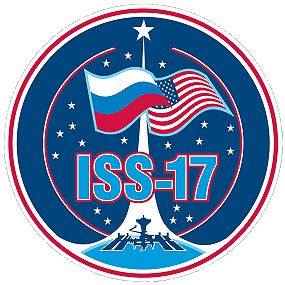 |
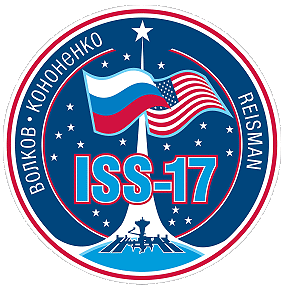 |
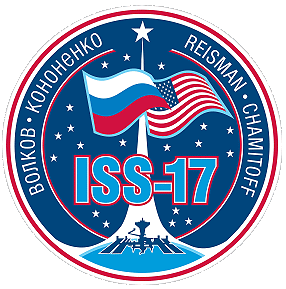 |
 |
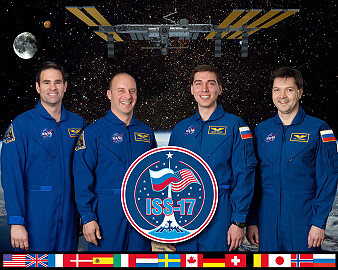
alternative crew photo |
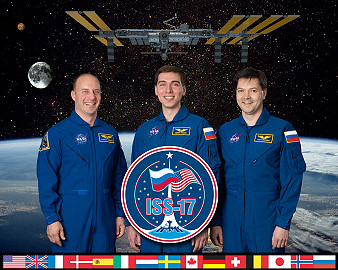
alternative crew photo |
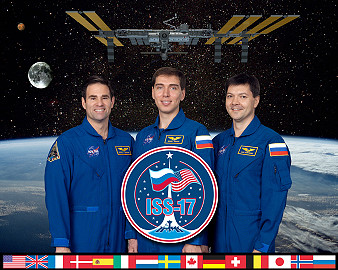
|
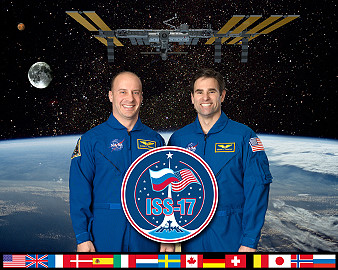
|
alternative crew photo |
|
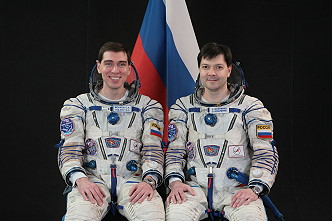 |
|
![]()
Crew, launch- and landing data
| No. | Nation | Surname | Given names | Position | Spacecraft (launch) |
Launch date |
Launch time |
Spacecraft (landing) |
Landing date |
Landing time |
Mission duration |
Orbits |
| 1 | Volkov | Sergei Aleksandrovich | ISS-CDR | Soyuz TMA-12 | 08.04.2008 | 11:16:38.922 UTC | Soyuz TMA-12 | 24.10.2008 | 03:36:49.9 UTC | 198d 16h 20m 11s | 3131 | |
| 2 | Kononenko | Oleg Dmitriyevich | Flight Engineer-1 | Soyuz TMA-12 | 08.04.2008 | 11:16:38.922 UTC | Soyuz TMA-12 | 24.10.2008 | 03:36:49.9 UTC | 198d 16h 20m 11s | 3131 | |
| 3 | Reisman | Garrett Erin | Flight Engineer-2 | STS-123 | 11.03.2008 | 06:28:13.984 UTC | STS-124 | 14.06.2008 | 15:15:17.014 UTC | 95d 08h 47m 03s | 1501 | |
| 4 | Chamitoff | Gregory Errol | Flight Engineer-2 | STS-124 | 31.05.2008 | 21:02:12.006 UTC | STS-126 | 30.11.2008 | 21:25:05.599 UTC | 183d 00h 22m 54s | 2879 |
Backup Crew
| No. | Nation | Surname | Given names | Position |
| 1 | Surayev | Maksim Viktorovich | ISS-CDR | |
| 2 | Skripochka | Oleg Ivanovich | Flight Engineer | |
| 3 | Kopra | Timothy Lennart | Flight Engineer | |
| 4 | Kopra | Timothy Lennart | Flight Engineer |
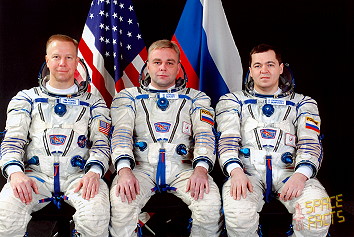 |
 |
Expedition Report
|
Launch from the Baikonur Cosmodrome (Sergei
Volkov and Oleg
Kononenko with
Soyuz
TMA-12). Gregory
Chamitoff arrived on June 02, 2008 with
STS-124. The Expedition 17 officially began with undocking of Russian spacecraft Soyuz TMA-11 on April 19, 2008 at 05:06:27 UTC and Expedition 16 ended. Yi Soyeon flew on board Soyuz TMA-12 as a guest of the Russian government through the Korean Astronaut Program after the Korean government paid the Russian government 25 million US dollars in agreement to support the first Korean astronaut in space. Her role aboard the Soyuz is referred to as a Spaceflight Participant in English-language Russian Federal Space Agency and NASA documents and press briefings. Ko San was originally scheduled to fly, with Yi Soyeon as his backup. On March 10, 2008, it was announced that Ko San breached regulations surrounding removal of books from the training center in Russia, and therefore would not be allowed to fly. Yi Soyeon spent eight days conducting scientific experiments aboard the International Space Station. Progress M-64 was launched at 20:22 UTC on May 14, 2008. The spacecraft docked with the nadir port of the Zarya module at 21:39 UTC on May 16, 2008, two minutes behind schedule, by means of the Kurs system. Progress M-65 carried 2,112 kilograms (4,656 lb) of cargo to the International Space Station. 1,292 kilograms (2,848 lb) of this was dry cargo, including food for the crew, equipment for conducting scientific research, and a replacement Sokol KV-2 spacesuit for Sergei Volkov, as his original suit had been damaged. It also carried a docking target for attaching the MRM-2 module to the zenith port of the Zvezda module. In addition to dry cargo, it carried 1,230 kilograms (2,710 lb) of fuel for reboosting and refueling the ISS, 29 kilograms (64 lb) of oxygen and 21 kilograms (46 lb) of air for the crew to breathe, and 420 kilograms (930 lb) of water. Following undocking at 19:46 UTC on September 01, 2008, it spent a week in free-flight conducting experiments for the Plazma-Progress program. It was deorbited on September 08, 2008, with the deorbit burn beginning at 20:47. The spacecraft burned up in the atmosphere over the Pacific Ocean, with any remaining debris landing in the ocean at around 21:33. Space Shuttle STS-124 docked with the International Space Station on June 02, 2008. STS-124 (ISS-1J JEM PM JEM RMS) delivered the Pressurized Module (JEM PM) of the Japanese Experiment Module (JEM), called Kibo, to the International Space Station (ISS). Kibo was berthed to the Harmony module and the pressurized section of the JEM Experiment Logistics Module, brought up by the STS-123 crew, was moved from Harmony to the JEM PM. The Japanese Remote Manipulator System, a robotic arm, was also delivered by STS-124 and attached to Kibo. The entire Kibo laboratory is being brought up over three missions. Gregory Chamitoff replaced Garrett Reisman who arrived on the station in March 2008 and was completing three months as a station Flight Engineer. Garrett Reisman returned to Earth aboard Discovery. Gregory Chamitoff returned to Earth on shuttle mission STS-126, while Sergei Volkov and Oleg Kononenko returned in Soyuz TMA-12 in October 2008. Kibo is 14 feet (4.3 meters) longer than Columbus and 9 feet (2.7 meters) longer than the U.S. Destiny laboratory. It joins the first component of the Japanese segment of the station, the Experiment Logistics Module- Pressurized Section (JEM ELM-ES), that was launched on the last shuttle flight, STS-123, in March 2008. The logistics module will be robotically detached from the top port of Harmony during the mission and reattached to the top port of Kibo to serve as a storage depot. The JEM ELM-ES was launched with eight racks of science gear and control equipment that will be transferred to the JPM for installation. In all, Kibo can house up to 23 racks of equipment and experiments that will involve research in space medicine, biology, Earth observations, materials production, biotechnology and communications. The new pressurized module also is equipped with its own robotic manipulator system and an airlock. The Japanese robotic device will be comprised of two separate six-jointed arms, the main arm that measures 32.5 feet (9.9 meters) and can handle up to seven tons of hardware, and a small fine arm, a 6.2-foot (1.9 meters) extension that will be used for delicate payload operations. The small fine arm will be launched later on a new Japanese resupply ship for the station called the H-II Transfer Vehicle (HTV). The airlock ultimately will be used once the final components for the Japanese segment of the station are delivered on shuttle mission STS-127. That flight will install the Exposed Facility (JEM EF) and the Exposed Logistics Module - Exposed Section (JEM ELM-ES). Some experiments will be mounted on a sliding platform that will move out of the depressurized airlock and handed off to the small fine arm for installation onto the exposed section. The airlock is not designed for spacewalks. A few hours after Discovery's docking on the third day of the flight, Gregory Chamitoff and Garrett Reisman exchanged custom-made Russian Soyuz spacecraft seat liners. With that exchange, Gregory Chamitoff became a part of the Expedition 17 space station crew and Garrett Reisman became part of Discovery's crew. Gregory Chamitoff joined Expedition Commander Sergei Volkov and Flight Engineer Oleg Kononenko who were launched to the complex in the Soyuz TMA-12 spacecraft on April 08, 2008 from the Baikonur Cosmodrome in Kazakhstan. Following a standard safety briefing by station commander Sergei Volkov, the crews will get to work, activating the Station to Shuttle Power Transfer System (SSPTS) to provide additional electricity for the longer operation of shuttle systems. Discovery carried with its replacement parts in a mid-deck locker for a malfunctioning toilet on the International Space Station. The crew had been using other facilities for waste until the new replacement parts were installed on the Zvezda module of the ISS. The first EVA was performed by Michael Fossum and Ronald Garan on June 03, 2008 (6h 48m) to transfer of the Orbiter Boom Sensor System back to the shuttle from its temporary location of the station's truss, or backbone. The crew then prepared the JEM PM for its removal from the shuttle's payload bay. Later that day, the JEM PM was installed on the port side of Harmony. The first objective was to transfer the OBSS left after the previous shuttle mission from the station's truss to space shuttle Discovery. Most of the tasks fall to Ronald Garan, who was releasing the stanchions holding the boom to the truss and removing a bag that had protecting the boom's sensor package. Just before the station's robotic arm took control of the boom and handed it off to the shuttle's robotic arm, Michael Fossum detached the keep-alive umbilical that has been providing the boom's systems with power while stowed. The boom was used later in the mission to inspect the shuttle's heat shield. Next, the spacewalkers prepared the Kibo laboratory for installation. While Ronald Garan was working on the boom, Michael Fossum inspected the Harmony Node's left side active common berthing mechanism to ensure that it's ready to attach to Kibo. He also opened a window cover to provide the crew inside with a good view of the installation. After the boom work was done, Ronald Garan and Michael Fossum worked together in the shuttle's cargo bay to remove contamination covers from the surface where the module will connect to Harmony. Michael Fossum also disconnected the heater cables connecting the module to the shuttle and removed three bolts that lock the shutters of Kibo's forward window in place for launch. The spacewalkers' final tasks of the spacewalk took them to the station's starboard solar alpha rotary joint. The 10-foot-wide (3.1 meters) rotary joint, which allows the station's starboard solar arrays to rotate and track the sun, began experiencing increased vibration and power usage in the fall of 2007. Inspections turned up metal shavings inside the joint. One of the joint's 12 trundle bearing assemblies, which allow the joint's outboard ring to rotate around its inboard ring, was removed. Ronald Garan installed a replacement for that trundle bearing assembly. Meanwhile, Michael Fossum inspected a potentially damaged area on the joint to determine whether there was debris sitting on the surface of the metal, or a divot in the metal. A similar inspection was performed during STS-123, but Michael Fossum used sharper tools to give him more tactile feedback. Michael Fossum also tried out techniques for cleaning the surface of the joint's race ring. First, he tried removing a section of the debris, using a putty knife as a scraper. Next, he applied grease to the surface and then tried the scraper again. And finally, Michael Fossum tried using a wipe and grease. On flight day 5 the hatch to the Kibo lab was opened at 21:05 UTC. The crew also repaired the malfunctioning ISS toilet. The second EVA by Michael Fossum and Ronald Garan occurred on June 05, 2008 (7h 11m) to install covers and external television equipment on the JEM PM and remove covers on the JEM RMS, which was later installed on flight day 8. The spacewalkers also prepared for the flight day 7 relocation of the Japanese logistics module. The crew began the second spacewalk by installing on the Kibo laboratory two cameras that will be used to judge clearances for the module's robotic arm. Ronald Garan installed the forward camera, while Michael Fossum worked on the aft. They then worked together to remove the seven thermal covers on each of the robotic arms' six joints and its end effecter. Each cover required the spacewalkers to remove two fasteners and disconnect two grounding wires. Next, they prepared the laboratory's top active common berthing mechanism for the attachment of a smaller section of the module, the JLP, which was delivered during STS-123. To do so, they removed the berthing mechanism's thermal cover, the bolts securing two micrometeoroid orbital debris shields and a launch lock, and inspected its surface. They also installed thermal covers on the metal post that connected the laboratory to the shuttle's cargo bay. After that, Ronald Garan and Michael Fossum split up to prepare for a nitrogen tank assembly swap that they performed on the mission's third spacewalk. The nitrogen tank assembly uses high-pressure nitrogen gas to control the flow of ammonia out of the ammonia tank assembly. Ammonia is used to control the temperature on the station's exterior. Michael Fossum moved to the left side of the station's truss, where a spare nitrogen tank assembly was located on External Stowage Platform 3. He installed an articulating portable foot restraint onto the platform for use during the next spacewalk, and loosened the four bolts that anchored the nitrogen tank assembly to the platform. And to prevent overheating during the swap, he installed thermal covers over the assembly's quick disconnect lines. Ronald Garan also loosened the bolts and installed thermal covers on the old nitrogen tank assembly, which was on the starboard truss. In addition, he disconnected three electrical connections and the nitrogen lines that attached the assembly to its corresponding ammonia tank assembly. For the final tasks of the spacewalk, Ronald Garan joined Michael Fossum on the left truss to remove an external television camera that had a failing power supply. They brought the camera inside with them, where the power supply was replaced, and then reinstalled it during the third spacewalk. The crew moved the Kibo Logistics Module from Harmony to the Pressurized Module on flight day 7. On flight day 8 Akihiko Hoshide and Karen Nyberg moved two of the six joints on the Japanese Kibo lab's robotic arm for the first time, maneuvering them very slightly with a series of commands. The third and final EVA by Michael Fossum and Ronald Garan was conducted on June 08, 2008 (6h 33m) to replace a failed nitrogen tank assembly on the station's truss with a spare. That was temporarily stored on one of the station external stowage platforms. They also retrieved a failed camera system on the truss. Replacing the depleted nitrogen tank assembly required Ronald Garan to spend much of his third spacewalk on the station's robotic arm. He started the spacewalk by installing a width extender to increase the robotic arm's reach, climb into a foot restraint attached to the width extender and remove four bolts holding the old nitrogen tank assembly in place on the starboard truss. After installing a handle on the assembly, he removed it from the truss and carried it to the external stowage platform, via the robotic arm. Meanwhile, Michael Fossum removed the spare nitrogen tank assembly from the platform to make room for the old one, and stored it on the other side of the platform. When Ronald Garan arrived with the old assembly, Michael Fossum guided it into place and began securing it to the platform with four bolts. Once one of the four bolts was secured, Ronald Garan removed his handle from the old assembly, attached it to the new one and rode the robotic arm back to the starboard truss with the nitrogen tank assembly in tow. He removed his handle, installed the bolts to secure it to the truss and connected the necessary electrical link. Then he got off the robotic arm and moved to the back of the truss to connect the assembly's nitrogen lines to the ammonia tank assembly. Meanwhile, Michael Fossum finished securing the old nitrogen assembly and moved to the Kibo module to finish outfitting it. He removed launch locks and thermal covers from the two cameras on the module's robotic arm, as well as the launch locks on the module's aft window. The window had been blocked by the robotic arm during the first spacewalk, when he removed the launch locks on the module's forward window. He then deployed two micrometeoroid debris shields on either side of the connection between the larger laboratory module and the recently relocated experiments logistics module. Once that was done, Michael Fossum returned to the airlock retrieve the external television camera with its new power supply. He met Ronald Garan back on the port truss, where they reinstalled the camera. On June 09, 2008 Kibo's robot arm was extended to its full 33 feet (10.1 meters), with all six joints tested. The astronauts also opened the hatch to the Kibo's storage unit. On June 11, 2008 STS-124 undocked from the ISS and moved to a distance of about 450 feet (137.2 meters), where Kenneth Ham began to fly around the station in its new configuration. Once Discovery completed 1.5 revolutions of the complex, Kenneth Ham fired Discovery's jets to leave the area. The shuttle moved about 46 miles (74 km) from the station and remained there while ground teams analyzed data from the late inspection of the shuttle's heat shield. The distance was close enough to allow the shuttle to return to the station in the unlikely event that the heat shield is damaged, preventing the shuttle's safe re-entry. The first station EVA by Sergei Volkov and Oleg Kononenko occurred on July 10, 2008 (6h 18m) to inspect their Soyuz TMA-12 spacecraft, checking the five locks that attach the return module to the propulsion module, and retrieve a suspect pyrotechnic bolt for inspection by engineers on the ground. The second and final EVA was performed by Sergei Volkov and Oleg Kononenko on July 15, 2008 (5h 54m) to remove and install science experiments. They also installed rendezvous equipment for a new Russian module scheduled for launch late summer 2009. Progress M-65 was launched at 19:50 UTC on September 10, 2008. The spacecraft docked with the aft port of the Zvezda module at 18:43 UTC on September 17, 2008. Docking had originally been scheduled for 21:01 UTC on September 12, 2008, but was delayed after Hurricane Ike forced NASA to close the Johnson Space Center, which houses the US mission control center for the ISS. A backup facility at the Marshall Space Center was used during the docking. Progress M-65 carried supplies to the International Space Station, including food, water and oxygen for the crew and equipment for conducting scientific research. It also carried a new Orlan-MK spacesuit to replace one of the older Orlan-M suits previously used for EVA's from the station. Following undocking at 16:19 UTC on November 15, 2008, the freighter conducted a Plazma-Progress experiment. It was deorbited on December 08, 2008, with the 142 second deorbit burn beginning at 08:02. The spacecraft burned up in the atmosphere over the Pacific Ocean, with any remaining debris landing in the ocean at around 08:49. ELaboratore Immagini Televisive - Space 2 (ELITE-S2) will investigate the connection between the brain, visualization and motion in the absence of gravity. By recording and analyzing the three-dimensional motion of astronauts, this study will help engineers apply ergonomics into future spacecraft designs and determine the effects of weightlessness on breathing mechanisms for long-duration missions. Results might also be applied to neurological patients on the ground with impaired motor control. This experiment is a cooperative effort with the Italian Space Agency (ASI). Space Flight-Induced Reactivation of Latent Epstein-Barr Virus (Epstein-Barr) performs tests to study changes in the human immune function. Using blood and urine samples collected from crew members before and after spaceflight, the study will provide insight for possible countermeasures to prevent the potential development of infectious illness in crew members during flight. Validation of Procedures for Monitoring Crew Member Immune Function (Integrated Immune) will assess the clinical risks resulting from the adverse effects of spaceflight on the human immune system. The study will validate a flight-compatible immune monitoring strategy by collecting and analyzing blood, urine and saliva samples from crew members before, during and after spaceflight to monitor changes in the immune system. Behavioral Issues Associated with Isolation and Confinement: Review and Analysis of Astronaut Journals (Journals) is studying the effect of isolation by using surveys and journals kept by the crew. By quantifying the importance of different behavioral issues in crew members, the study will help NASA design equipment and procedures to allow astronauts to best cope with isolation and long-duration spaceflight. Test of Midodrine as a Countermeasure against Post-Flight Orthostatic Hypotension - Long (Midodrine-Long) measures the ability of the drug midodrine, as a countermeasure, to reduce the incidence or severity of orthostatic hypotension - dizziness caused by the blood-pressure decrease that many astronauts experience when returning to Earth's gravity. Nutritional Status Assessment (Nutrition) is NASA's most comprehensive in-flight study to date of human physiologic changes during long-duration spaceflight. Its measurements will include bone metabolism, oxidative damage, nutritional assessments and hormonal changes. This study will impact both the definition of nutritional requirements and development of food systems for future space exploration missions to the moon and beyond. This experiment will also help researchers understand the impact of countermeasures such as exercise and pharmaceuticals on nutritional status and nutrient requirements for astronauts. The National Aeronautics and Space Administration Biological Specimen Repository (Repository) is a storage bank used to maintain biological specimens over extended periods of time and under well-controlled conditions. Samples from the station, including blood and urine, will be collected, processed and archived during the pre-flight, in-flight and post-flight phases of the missions. This investigation has been developed to archive biological samples for use as a resource for future spaceflight research. Stability of Pharmacotherapeutic and Nutritional Compounds (Stability) studies the effects of radiation in space on complex organic molecules, such as vitamins and other compounds in food and medicine. This could help researchers develop more stable and reliable pharmaceutical and nutritional countermeasures that are suitable for future long-duration missions. Lab-on-a-Chip Application Development-Portable Test System (LOCAD-PTS) is a handheld device for rapid detection of biological and chemical substances aboard the space station. Astronauts will swab surfaces within the cabin, add swab material to the LOCAD-PTS, and within 15 minutes obtain results on a display screen. The study's purpose is to effectively provide an early warning system to enable crew members to take remedial measures if necessary, to protect the health and safety of those on the station. Microgravity Acceleration Measurement System (MAMS) and Space Acceleration Measurement System - II (SAMS-II) measure vibration and quasi-steady accelerations that result from vehicle control burns, docking and undocking activities. The two different equipment packages measure vibrations at different frequencies. These measurements help investigators characterize the vibrations and accelerations that may influence space station experiments. Materials on the International Space Station Experiment 6 (MISSE-6A and 6B) is a test bed for materials and coatings attached to the outside of the space station that are being evaluated for the effects of atomic oxygen, direct sunlight, radiation and extremes of heat and cold. This experiment allows the development and testing of new materials to better withstand the rigors of space environments. Results will provide a better understanding of the durability of various materials in space, leading to the design of stronger, more durable spacecraft components. Coarsening in Solid Liquid Mixtures-2 (CSLM-2) examines the kinetics of competitive particle growth within a liquid metal matrix. During this process, small particles of tin suspended in a liquid tin-lead matrix shrink by losing atoms to larger particles of tin, causing the larger particles to grow, or coarsen. This study defines the mechanisms and rates of coarsening in the absence of gravitational settling. This work has direct applications to metal alloy manufacturing on Earth, including materials critical for aerospace applications, such as the production of better aluminum alloys for turbine blades. The Optimization of Root Zone Substrates (ORZS) for Reduced Gravity Experiments Program was developed to provide direct measurements and models for plant rooting instructions that will be used in future advanced life support plant growth experiments. The goal is to develop and enhance hardware and procedures to allow optimal plant growth in microgravity. Shear History Extensional Rheology Experiment (SHERE) is designed to investigate the effect of preshearing, or rotation on the stress and strain response of a polymer fluid, a complex fluid containing long chains of polymer molecules, being stretched in microgravity. The fundamental understanding and measurement of the extensional rheology of complex fluids is important for understanding container less processing, an important operation for fabrication of parts, such as adhesives or fillers, using elastomeric materials on future exploration missions. This knowledge also can be applied to controlling and improving Earth-based manufacturing processes. Crew Earth Observations (CEO) takes advantage of the crew in space to observe and photograph natural and human-made changes on Earth. The photographs record the Earth's surface changes over time, along with dynamic events such as storms, floods, fires and volcanic eruptions. These images provide researchers on Earth with key data to better understand the planet. Crew Earth Observations - International Polar Year (CEO-IPY) supports an international collaboration of scientists studying the Earth's polar regions from 2007 to 2009. Space station crew members photograph polar phenomena, including icebergs, auroras and mesospheric clouds in response to daily correspondence from the scientists on the ground. Earth Knowledge Acquired by Middle School Students (EarthKAM), an education experiment, allows middle school students to program a digital camera on board the station to photograph a variety of geographical targets for study in the classroom. Photos are made available on the Web for viewing and study by participating schools around the world. Educators use the images for projects involving Earth science, geography, physics and technology. Many other experiments are scheduled to be performed during the space shuttle missions that are part of Expedition 17. These experiments include: National Lab Pathfinder - Vaccine 1B (NLP-Vaccine 1B) is a commercial payload serving as a pathfinder for use of the ISS as a national laboratory after station assembly is complete. This payload contains a pathogenic, or disease-carrying organism, and tests whether the organism changes in microgravity in a way that allows it to become a viable base for a potential vaccine against infections on Earth and in microgravity. Validation of Procedures for Monitoring Crew Member Immune Function - Short Duration Biological Investigation (Integrated Immune - SDBI) will assess the clinical risks resulting from the adverse effects of spaceflight on the human immune system for space shuttle crew members. The study will validate a flight-compatible immune monitoring strategy by collecting and analyzing blood, urine and saliva samples from crew members before, during and after spaceflight to monitor changes in the immune system. Sleep-Wake Actigraphy and Light Exposure during Spaceflight - Short (Sleep-Short) examines the effects of spaceflight on the sleep-wake cycles of the astronauts during space shuttle missions. Advancing state-of-the-art technology for monitoring, diagnosing and assessing treatment of sleep patterns is vital to treating insomnia on Earth and in space. The Combustion Integrated Rack (CIR) is used to perform combustion experiments in microgravity. It is designed to easily be reconfigured on orbit to accommodate a wide variety of combustion experiments. The General Laboratory Active Cryogenic ISS Experiment Refrigerator (GLACIER) will serve as an on-orbit cold stowage facility as well as carry frozen scientific samples to and from the station and Earth via the space shuttle. This facility is capable of thermally controlling the samples between 4°C and -185°C. The Human Research Facility-1 (HRF-1) is designed to house and support life sciences experiments. It includes equipment for lung function tests, ultrasound to image the heart and many other types of computers and medical equipment. Human Research Facility-2 (HRF-2) provides an on-orbit laboratory that enables human life science researchers to study and evaluate the physiological, behavioral and chemical changes in astronauts induced by spaceflight. Minus Eighty-Degree Laboratory Freezer for ISS (MELFI) provides refrigerated storage and fast-freezing of biological and life science samples. It can hold up to 300 liters of samples ranging in temperature from -80°C, -26°C, or 4°C throughout a mission. The Destiny lab is outfitted with five EXPRESS Racks. EXPRESS, or Expedite the Processing of Experiments to the Space Station, racks are standard payload racks designed to provide experiments with utilities such as power, data, cooling, fluids and gasses. The racks support payloads in disciplines including biology, chemistry, physics, ecology and medicines. The racks stay in orbit, while experiments are changed as needed. EXPRESS Racks 2 and 3 are equipped with the Active Rack Isolation System (ARIS) for countering minute vibrations from crew movement or operating equipment that could disturb delicate experiments. In the Columbus Module, the Microgravity Science Glovebox (MSG) provides a safe environment for research with liquids, combustion and hazardous materials on the ISS. Without the MSG, many types of hands-on investigations would be impossible or severely limited on the station. Express Rack 3A, containing the European Modular Cultivation System (EMCS) facility, also is located in Columbus. EMCS is a large incubator that provides control over the atmosphere, lighting and humidity of growth chambers used to study plant growth. The facility was developed by the European Space Agency. On October 14, 2008 Russian spacecraft Soyuz TMA-13 brought the two new crewmembers of Expedition 18 to the station. Finally, the station command changed from Russian cosmonaut Sergei Volkov to US astronaut Michael Fincke. Expedition 17 officially ended with undocking of Soyuz TMA-12 on October 24, 2008 at 00:16:18 UTC. During the stay on board of the ISS the crew of Expedition 17 carried out the following scientific experiments: 3D-Space (Mental Representation of Spatial Cues During Space Flight), ALTEA-Dosi (Anomalous Long Term Effects in Astronauts' - Dosimetry), ANITA (Analyzing Interferometer for Ambient Air), Antigen (Optimization of Heterological Expresssion in Yeasts-True Yeasts in Microgravity for Example Synthesis of the HBS Antigen of the Virus Hepatitis B), ARISS (Amateur Radio on the International Space Station), Bar (Choice and Development of Methods and Instruments to Detect the Location of a Loss of Pressurization of a Module on ISS), BCAT-3-4-CP (Binary Colloidal Alloy Test - 3 and 4: Critical Point), BCAT-4-Poly (Binodal Colloidal Aggregation Test - 4: Polydispersion), BIMS (Assessment of the Efficiency of the Use of Telemedicine Technologies On-Board ISS), Biodegradation (Initial stage of Biodegradation and Biodeterioration in Space), Bioemulsia (Research and Development of a Self-Contained Reactor of the Shielded Type For Production of Biomass of Microorganisms and Biologically Active Substances), Biorisk (Influence of Factors of the Space Environment on the Condition of the System of Microorganisms-Hosts Relating to the Problem of Environmental Safety of Flight Techniques and Planetary Quarantine), Biotrek (Influence of the Flow of Heavily Charged Particles of Space Radiation on Gentic Properties of Cell Production), BTN-M1 (Examination of the Flow of High Speed and Thermal Neutrons), Buzz Lightyear (Buzz Lightyear), Cell Wall (Reverse Genetic Approach to Exploring Genes Responsible for Cell Wall Dynamics in Supporting Tissues of Arabidopsis Under Microgravity Conditions), CEO (Crew Earth Observations), CEO-IPY (Crew Earth Observations - International Polar Year), Conjugation (Development of Methods for Designing New Recombinants Producing Strains of Bacteria in Space Flight), CSI-02 (Commercial Generic Bioprocessing Apparatus Science Insert - 02: Silicate Garden, Seed Germination, Plant Cell Culture and Yeast), CSLM-2 (Coarsening in Solid Liquid Mixtures-2), Diatomeya (Stability of Geographical Position and Configuration of Borders of Bioproductive Water Zones of the World Oceans, Observations by Orbition Station Crews), DOSTEL (DOSimetry TELescopes), Dykhanie (Regulation and Biomechanics of Respiration in Space Flight), EarthKAM (Earth Knowledge Acquired by Middle School Students), EDOS (Early Detection of Osteoporosis in Space), Ekon (Experimental Survey on Evaluating the Possibility of Using th Russian Segment of ISS for Environmental Inspection of Work Areas of Various Facilities (Features)), ELITE-S2 (ELaboratore Immagini TElevisive - Space 2), Environmental Monitoring (Environmental Monitoring of the International Space Station), EPO-Demos (Education Payload Operation - Demonstrations), Epstein-Barr (Space Flight Induced Reactivation of Latent Epstein-Barr Virus), Geoflow-1 (Simulation of Geophysical Fluid Flow Under Microgravity-1), Identifikatsia (Identification of the Sources of Dynamic Loads on ISS), Inflight Education Downlinks (International Space Station Inflight Education Downlinks), Integrated Immune (Validation of Procedures for Monitoring Crewmember Immune Function), Integrated Immune-SDBI (Validation of Procedures for Monitoring Crewmember Immune Function - Short Duration Biological Investigation), ISS Acoustics (International Space Station Acoustic Measurement Program), JAXA-HDTV (Activation and Test Downlink of HDTV System), JAXA EPO 1 (Japan Aerospace Exploration Agency Education Payload Observation 1), Journals (Behavioral Issues Associated with isolation and Confinement: Review and Analysis of Astronaut Journals), Lactolen (Influence of Factors of Space Flight on Lactolen Producer Strains), LOCAD-PTS (Lab-on-a-Chip Application Development-Portable Test System), Marangoni-Exp (Chaos, Turbulence and its Transition Process in Marangoni Convection-Exp), MATI-75 (Educational Demonstration of the Effects of Shape and Size on the Recovery of Precompressed Plastic Material), Midodrine-Long (Test of Midodrine as a Countermeasure Against Post-flight Orthostatic Hypotension - Long), MISSE-6A and 6B (Materials International Space Station Experiment - 6A and 6B), NLP-Vaccine-MRSA (National Laboratory Pathfinder - Vaccine - Methicillin-resistant Staphylococcus aureus), NLP-Vaccine-Salmonella (National Laboratory Pathfinder - Vaccine - Salmonella), NOA-1 (Exhaled Nitric Oxide-1), NOA-2 (Exhaled Nitric Oxide-2), Nutrition (Nutritional Status Assessment), OChB (Influence of Factors of Space Flight on Superoxide Strain Producer), Otolith (Otolith Assessment During Postflight Re-adaptation), Pilot (Individual Characteristics of Psychophysiological Regulatory Status and Reliaility of Professional Activities of Cosmonauts in Long Duration Space Flight), Plasma-MKS (Plasma-ISS: Examination of Plasmic Environments on the External Surface of ISS Through the Characterization of Optical Radiance), Plasma-Progress (Observation of the Reflective Characteristics of the Spacecraft Plasma Environment from On-Board Thruster Activity Using Ground-Based Instruments), Plasma Crystal (Dusty and Liquid Plasma Crystals in Conditions of Microgravity), Plazmida (Transfer of Molecules of DNA by Conjugation in Space Flight), Pneumocard (Examination of the Influencing Factors of Space Flight on Autonomic Regulation of Blood Circulation, Respiration and Cardiac Contractile Function in Long Duration Space Flight), Profilaktika (Mechanisms of Action and Influence, and Effectiveness of Various Methods of Phrophylaxis Directed Toward Prevention of Disturbances of the Human Locomotion System in Weightlessness), Regeneratsia (Effect of Weightlessness on Processes of Regeneration by Electrophysiological and Morphological Factors), Relaksatia (Processes of Relaxation in the Ultraviolet Band Spectrum by High Velocity Interaction of Exhaust Products on ISS), Repository (National Aeronautics and Space Administration Biological Specimen Repository), Resist Wall (Role of Microtubule-Membrane-Cell Wall Continuum in Gravity Resistance in Plants), SHERE (Shear History Extensional Rheology Experiment), Sleep-Long (Sleep-Wake Actigraphy and Light Exposure During Spaceflight-Long), Sleep-Short (Sleep-Wake Actigraphy and Light Exposure During Spaceflight-Short), SOLO (SOdium LOading in Microgravity), Sonokard (Physiological Functions (cardio-respiratory) of Humans Using Contactless Methods During Sleep in Long Duration Space Flight), SPHERES (Synchronized Position Hold, Engage, Reorient, Experimental Satellites), Spin (Validation of Centrifugation as a Countermeasure for Otolith Deconditioning During Spaceflight), Stability (Stability of Pharmacotherapeutic and Nutritional Compounds), Ten'-Mayak (Study of Transmit/Receive Radio Signal Conditions in the Russian Segment of ISS Using the World-Wide Ham Radio Network), Uragan (Hurricane: Experimental Development of Groundbased System of Monitoring and Predicting the Progression of a Naturally Occurring Technogenic Catastrophe), Vsplesk (Burst: Monitoring of Seismic Effects - Bursts of High Energy Particles in Low Earth Space Region (Orbit)), WAICO (Waving and Coiling of Arabidopsis Roots at Different g-levels), Zag (Ambiguous Tilt and Translation Motion Cues After Space Flight), Zhenshen-2 (Study of the Development of Cell Cultures to Evaluate the Possibily of Increasing Biological Activity). |
EVA data
| Name | Start | End | Duration | Mission | Airlock | Suit | |
| EVA | Fossum, Michael | 03.06.2008, 16:22 UTC | 03.06.2008, 23:10 UTC | 6h 48m | STS-124 | ISS - Quest | EMU No. 3015 |
| EVA | Garan, Ronald | 03.06.2008, 16:22 UTC | 03.06.2008, 23:10 UTC | 6h 48m | STS-124 | ISS - Quest | EMU No. 3017 |
| EVA | Fossum, Michael | 05.06.2008, 15:04 UTC | 05.06.2008, 22:15 UTC | 7h 11m | STS-124 | ISS - Quest | EMU No. 3015 |
| EVA | Garan, Ronald | 05.06.2008, 15:04 UTC | 05.06.2008, 22:15 UTC | 7h 11m | STS-124 | ISS - Quest | EMU No. 3017 |
| EVA | Garan, Ronald | 08.06.2008, 13:55 UTC | 08.06.2008, 20:28 UTC | 6h 33m | STS-124 | ISS - Quest | EMU No. 3017 |
| EVA | Fossum, Michael | 08.06.2008, 13:55 UTC | 08.06.2008, 20:28 UTC | 6h 33m | STS-124 | ISS - Quest | EMU No. 3015 |
| Name | Start | End | Duration | Mission | Airlock | Suit | |
| EVA | Kononenko, Oleg | 10.07.2008, 18:48 UTC | 11.07.2008, 01:06 UTC | 6h 18m | ISS-17 | ISS - Pirs | Orlan-M No. 26 |
| EVA | Volkov, Sergei | 10.07.2008, 18:48 UTC | 11.07.2008, 01:06 UTC | 6h 18m | ISS-17 | ISS - Pirs | Orlan-M No. 27 |
| EVA | Kononenko, Oleg | 15.07.2008, 17:08 UTC | 15.07.2008, 23:02 UTC | 5h 54m | ISS-17 | ISS - Pirs | Orlan-M No. 26 |
| EVA | Volkov, Sergei | 15.07.2008, 17:08 UTC | 15.07.2008, 23:02 UTC | 5h 54m | ISS-17 | ISS - Pirs | Orlan-M No. 27 |
ISS Assembly
 |
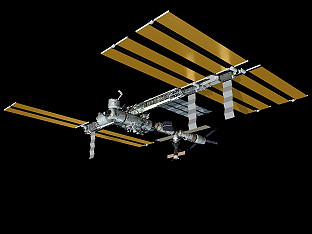 |
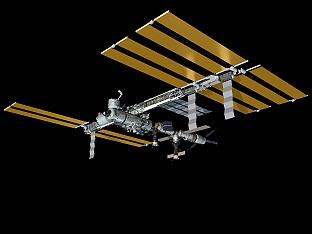 |
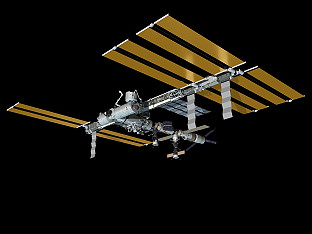 |
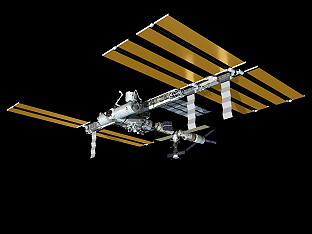 |
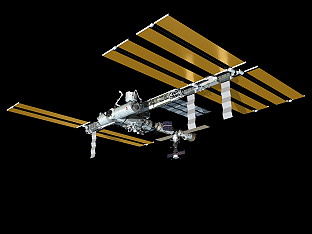 |
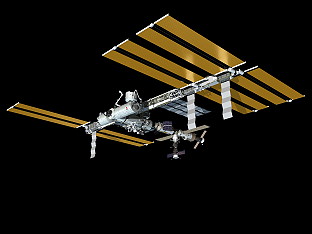 |
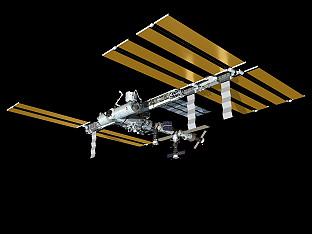 |
Photos / Graphics
 |
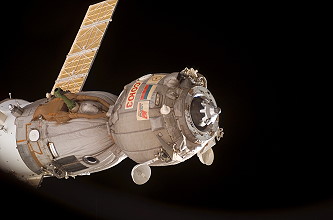 |
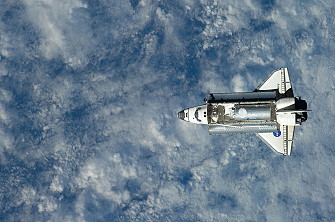 |
 |
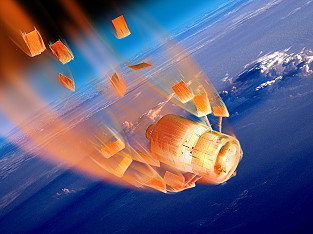 |
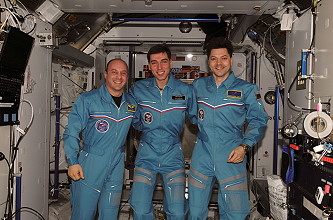 |
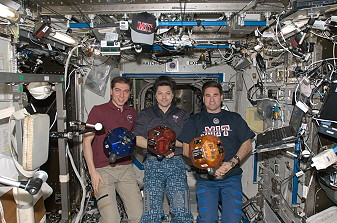 |
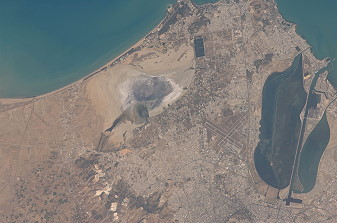 |
 |
 |
 |
 |
more Earth observation photos |
|
more EVA photos |
|
more onboard photos |
|
| © |  |
Last update on June 11, 2021.  |
 |